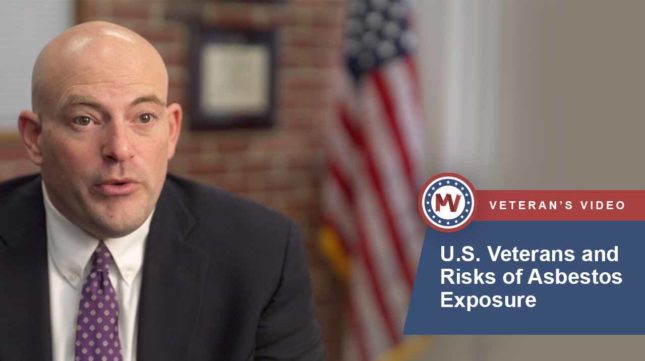Asbestos exposure can cause a wide range of diseases. This includes deadly cancers like mesothelioma and noncancerous illnesses like asbestosis. U.S. veterans are at an increased risk of asbestos-related diseases due to the widespread use of asbestos in the U.S. armed forces. Fortunately, the military offers medical care and financial compensation to those affected.
How Asbestos Exposure Causes Diseases

Asbestos is a durable mineral once used in thousands of products, such as construction materials and insulation. If these products were damaged or worn down, they could send asbestos fibers into the surrounding air — and those nearby could inhale or swallow the toxic mineral.
Microscopic asbestos fibers could then get stuck in the body and irritate healthy tissues and organs. The human body can't break down asbestos, and the fibers can cause long-term damage and diseases over time. Some may even develop cancer if the irritation causes healthy cells to mutate.
Asbestos-related diseases and cancers include:
- Mesothelioma
- Asbestosis
- Atelectasis (lung collapse)
- Chronic obstructive pulmonary disease (COPD)
- Lung cancer
- Pleural plaques
- Pleural thickening
Thankfully, U.S. veterans diagnosed with asbestos-related diseases can pursue benefits from the U.S. Department of Veterans Affairs (VA) as well as legal compensation from asbestos product manufacturers.
Who Is at Risk of Asbestos-Related Diseases?
Anyone exposed to asbestos could get sick 10-50 years later. Thousands of people develop asbestos-related conditions each year — and sadly, U.S. veterans are at an especially high risk.
The U.S. military relied on asbestos to build ships, bases, vehicles, and planes between the 1930s and early 1980s. The dangers of asbestos were largely unknown during this time, as manufacturers hid the truth to keep profits high. As a result, veterans make up 33% of all those diagnosed with mesothelioma.
Video Summary: In this video, VA-accredited attorney Eric Hall explains why U.S. veterans are at risk of asbestos-related diseases like mesothelioma. He also breaks down how affected veterans can access military benefits and medical treatment. Call (877) 450-8973 to get started. View Transcript
Veterans who served in the military between the 1930s and the 1980s were likely exposed to asbestos while they were on active duty. Usually, if you've developed an asbestos-related disease, you developed that disease because you had an excessive amount of exposure to asbestos.
If a veteran believes they were exposed to asbestos while serving in the military, we encourage them to call the Mesothelioma Veterans Center so that we can work together to help them file for VA benefits.
The VA will recognize any asbestos-related disease as long as your asbestos exposure happened while you were on active duty in the military.
In addition to VA benefits, the Mesothelioma Veterans Center can connect veterans with world-renowned physicians and nurses on staff that can answer any of your treatment questions. We encourage veterans to call and find out how we can help them.
Types of Asbestos-Related Diseases
Asbestos exposure can lead to life-threatening cancers, harmful noncancerous diseases, as well as a few low-risk health problems.
There is no way to predict what type of asbestos disease (if any) someone will suffer from if they've been exposed. It depends on where the asbestos fibers end up getting stuck in the body, among other factors not fully understood by medical professionals.
Below, get a breakdown of common asbestos-related diseases and how they develop.
Mesothelioma
Asbestos is a known carcinogen (cancer-causing substance) linked to several types of cancers. The most notable is mesothelioma.
Mesothelioma is a cancer that can form in the linings of the lungs (pleura), abdomen (peritoneum), heart (pericardium), or testes (tunica vaginalis), according to the National Cancer Institute (NCI).
Walter, a U.S. Navy veteran, developed mesothelioma decades after working with asbestos during his military service.
“I asked them what the material was made out of and they told me it was asbestos. It didn’t kill anybody on the spot that’s for sure, but it took years later when it started catching up with us. But, my understanding [is] that the powers-that-be knew [of the risks].”
– Walter, U.S. Navy Veteran
Other Cancers
Besides mesothelioma, asbestos exposure can lead to many types of cancer. Which cancers will form depends on where the fibers get stuck in the body.
Other cancers linked to asbestos exposure include:
- Colon cancer
- Laryngeal cancer
- Lung cancer
- Ovarian cancer
- Rectal cancer
- Stomach cancer
Learn more about the cancers caused by asbestos exposure.
Asbestosis
Asbestosis is a non-cancerous but life-threatening disease. It occurs when asbestos fibers get stuck in the alveoli, tiny air pockets in the lungs that swap oxygen for carbon dioxide. Asbestos fibers irritate the alveoli, causing scarring and decreased lung function.
Common symptoms of asbestosis include:
- Chest pain
- Constant cough
- Shortness of breath
- Swelling of the fingers (clubbing)
- Loss of appetite
- Weight loss
According to the Mayo Clinic, having asbestosis may increase the risk of lung cancer, especially among smokers. There’s no cure for asbestosis but supplemental oxygen and physical therapy can ease symptoms. A lung transplant may also be needed in serious cases.
Atelectasis
Atelectasis is the medical term for when a lung collapses. A lung may collapse if the lung lining becomes inflamed and constricted. It may also occur as a side effect of other asbestos diseases, such as asbestosis, or as a complication from surgery.
If someone goes in for a chest X-ray or another type of imaging scan, atelectasis may be mistaken for a cancerous tumor at first.
Fortunately, doctors can treat atelectasis using breathing exercises, surgery, and other methods. This condition often improves with treatment.
COPD
Chronic obstructive pulmonary disease (COPD) is a group of conditions that limit lung function. According to the Centers for Disease Control and Prevention (CDC), these conditions include emphysema and bronchitis.
While often smoking causes COPD, it can also be caused by asbestos. For example, the VA granted benefits to a veteran who developed COPD from exposure to asbestos and other chemicals while serving in the Vietnam War. There’s no cure but treatments like medications and physical therapy can help manage symptoms.
If you or a loved one has an asbestos-related illness like COPD, VA benefits might be available. Get a Free Veterans Packet for more information.
Pleural Effusion
Pleural effusions occur when fluid builds up in the lung lining. Asbestos fibers may cause pleural effusions by irritating the lung lining. Effusions are often seen in patients with pleural mesothelioma.
Symptoms of pleural effusions include:
- A dry cough that won't go away
- Chest pain
- Difficulty breathing
Many who develop pleural effusions do not have symptoms, according to the VA’s Veterans Health Library.
Doctors can drain pleural effusions using a needle (thoracentesis). It is common for effusions to come back, however. Doctors may recommend a catheter or try to seal the pleura with talc if this happens.
Diffuse Pleural Thickening
In cases of diffuse pleural thickening, the lung lining becomes stiff and scarred, leading to difficulty breathing. It can be caused by asbestos exposure or may be a symptom of other asbestos-related diseases like pleural effusions or pulmonary fibrosis.
Diffuse pleural thickening doesn’t cause severe symptoms, so treatments are not usually needed. That said, doctors can help patients manage the other conditions that may have caused the pleura to thicken.
Pleural Plaques
Pleural plaques are buildups of collagen, a natural protein, that form in the lining of the lungs. The collagen fibers harden into small clumps as part of the body’s immune response to asbestos fibers. They are the most prevalent asbestos-related lung disease.
There are no symptoms associated with pleural plaques, and they do not pose a threat to human health. However, those with pleural plaques may have a higher risk of other asbestos-related diseases due to their exposure.
Other Asbestos Exposure Diseases
- Peritoneal effusion: This is fluid buildup in the abdominal lining. It is also known as ascites and may be caused by peritoneal mesothelioma. It causes abdominal pain, loss of appetite, and weight gain, according to the NCI.
- Pericardial effusion: This occurs when fluid builds up in the lining of the heart. Symptoms include rapid heartbeat, swelling of the limbs, and chest pain.
- Pleural fibrosis: This is a term used to describe scarring of the lung lining. It may cause breathing problems or even failure of the respiratory system.
- Pleurisy: Also known as pleuritis, pleurisy is a condition where the lung lining becomes inflamed. Pleurisy causes pain during breathing. It is often associated with pleural effusions and atelectasis, according to the Mayo Clinic.
- Pulmonary fibrosis: Pulmonary fibrosis indicates the lungs have been scarred. According to the American Lung Association (ALA), pulmonary fibrosis prevents the lungs from properly expanding. The body gets less oxygen as a result.
Legal Options for Asbestos-Related Diseases
The manufacturers of asbestos-based products knew people could get sick from exposure decades before the public did. However, they did not warn the public or the U.S. military. Instead, they hid the risks to keep making money.
Today, those suffering from most asbestos-related diseases can pursue financial compensation from these companies.
Compensation is awarded through:
- Lawsuits: Through a mesothelioma lawsuit, manufacturers may be forced to compensate victims for causing their asbestos-related illnesses. These lawsuits award $1 million on average. No branch of the U.S. military or government will face legal action.
- Asbestos trust funds: Some manufacturers of asbestos-based products declared bankruptcy to avoid being sued. However, these companies were forced to establish trust funds so victims would still get compensated. An estimated $30 billion is currently available in asbestos trust funds.
Further, filing a lawsuit or trust fund claim does not prohibit a veteran from receiving VA benefits. Connect with a mesothelioma lawyer to see if you can pursue legal compensation.
Help for Veterans With Asbestos-Related Diseases
U.S. veterans are at a very high risk of diseases caused by asbestos since the military relied on this substance in its ships, bases, vehicles, planes, and shipyards for decades. Thankfully, veterans who got sick after being exposed to asbestos while serving can file for a wide range of VA benefits.
VA benefits include:
- Medical care from some of the best mesothelioma doctors
- Monthly financial payouts
- Survivor benefits for qualifying family members
- Upcoming treatments through clinical trials in select cases
The Mesothelioma Veterans Center is dedicated to helping all veterans with asbestos-related diseases access the benefits they may deserve. Our team is well-prepared to help you pursue VA benefits and other forms of compensation.
Get help filing for VA benefits now.
Questions About Asbestos-Related Diseases
How long can asbestos-related diseases take to develop?
It typically takes 10-50 years for the health effects of asbestos-related diseases to become apparent. As a result, most patients diagnosed with asbestos illnesses are in their 70s.
However, younger adults and even children can get mesothelioma or other asbestos-related diseases in very rare cases.
Can I pursue compensation for asbestos exposure?
Yes. You may be able to receive compensation if you got sick after being exposed to asbestos.
If you were exposed to asbestos but do not have an asbestos-related illness, keep a close watch on your health. Make sure to tell your doctor about your exposure history, as you may qualify for compensation if you later develop an asbestos disease.
What types of asbestos can cause illnesses?
There are six types of asbestos, and all types have the potential to cause disease.
Asbestos fibers are broken up into two major groups: amphibole and serpentine. Most types of asbestos (amosite, anthophyllite, crocidolite, actinolite, and tremolite) belong to the amphibole group. Only chrysotile asbestos belongs to the serpentine group.
How can you prevent an asbestos-related disease?
The only way to fully prevent an asbestos-related disease is to not be exposed to asbestos. If you've already been exposed, take note of how, when, and where. See a doctor if you start to show possible symptoms of an asbestos-related disease.
If you aren't sure how or where you were exposed, get in touch with a lawyer. Mesothelioma attorneys can help you pinpoint your exposure and identify the products you were exposed to.
How many people die from asbestos related-diseases each year?
Asbestosis, mesothelioma, and asbestos lung cancer kill a total of 12,000-15,000 people in the United States every year, according to data collected by the Environmental Working Group (EWG).
The total number of annual deaths from asbestos is likely higher, but more research is needed to get more accurate numbers.


